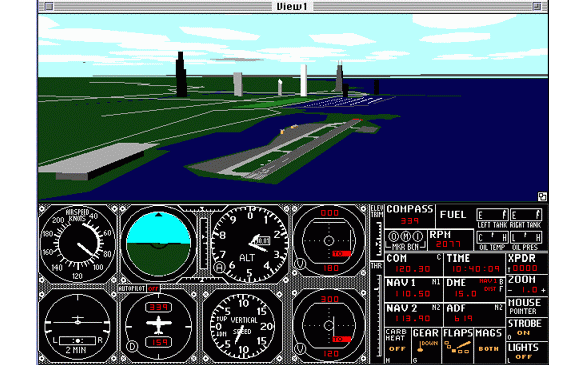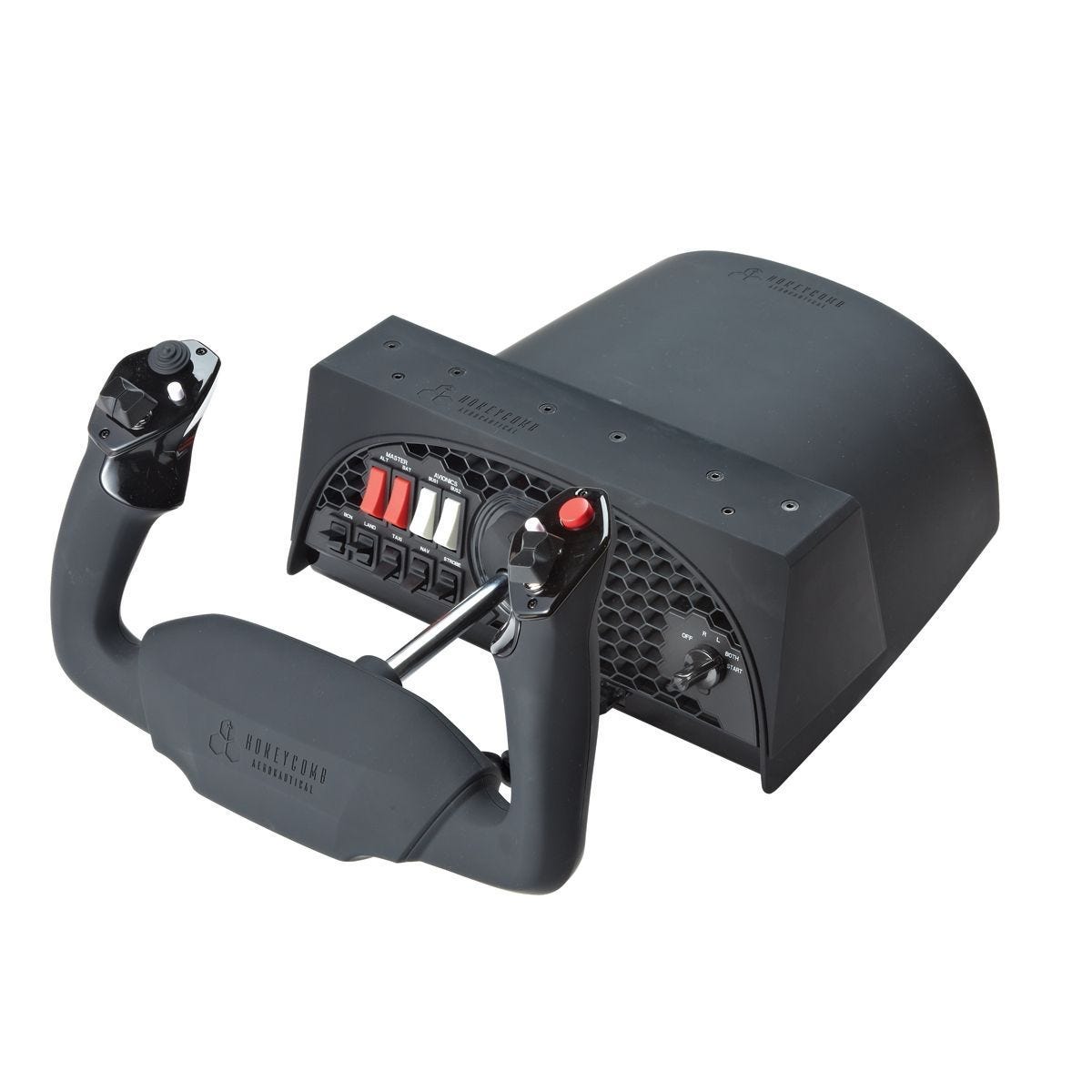What flight simulators mean for the next generation of aviators
Did you ever fly out of Meigs field in downtown Chicago before it closed? It’s one of those airports you will never forget if you were lucky enough to visit before the painful closure in 2003. Beyond its reputation as a scenic and convenient access point to downtown Chicago, it was just as memorable to many pilots for a different reason. Ask just about any pilot today who learned to fly in the late 90s or early 2000s and memories will flood back to the view from the departure end of Runway 36 at KCGX, preparing for takeoff in Microsoft Flight Simulator. For many, including me, this was the first introduction to the excitement and freedom of general aviation.

After mastering the traffic pattern over Lake Michigan and buzzing the Hancock Building and Sears Tower, it was only natural to switch over to Patty Wagstaff’s Extra 300S and fly the BF Goodrich-sponsored aerobatic airplane for some high performance inverted maneuvers. Most of us had no idea what we were doing, but thanks to an inexpensive yoke or joystick and the family computer in the home office, we learned more about airplane control, flight instruments and aerodynamics than we likely realized at the time.
There’s no question that the countless hours of joyriding around the U.S. in Flight Sim led me to choose a career path in aviation. And I can say for a fact that the experience and knowledge indirectly gained from manipulating the controls of the Cessna 172 and studying the instrument panel trimmed more than a few hours off the time to earn my Private pilot certificate in 2000.
Over the last 10 to 15 years though, it seems like flight simulators lost their magic. While I’m sure the modern versions of these platforms still inspired many to earn their wings, they didn’t offer the same emotional connection as Flight Sim 95 or Flight Sim 2004. The simulators of the past decade are as technically accurate as it gets and allow you to flip every last switch in an Airbus or King Air cockpit, but they felt more mechanical in nature and didn’t have the “it” factor that the original Flight Sim offered.
Change is in the air though, as Microsoft debuted an all-new version of Flight Simulator last year, and it’s hands-down the most capable and inspiring version yet in the product’s 38-year history. If you haven’t seen it yet, check out the demo videos on Microsoft’s website, or one of the hundreds of videos on YouTube, and you’ll be amazed. The unparalleled visuals incorporate over two petabytes of satellite and 3D photogrammetry data to show airports, structures and terrain around the world in detail never seen before.
The new scenery is a big part of why the new Flight Sim delivers the “it” factor aviation enthusiasts crave, providing the lifelike views from the cockpit while flying low and slow. At Sporty’s, we regularly fly to regional airport diners for $100 pancakes at sunrise before the work day begins, and there’s an unwritten rule to stay below 1,000’ AGL during the short hops in an effort to help appreciate the journey and the rolling hills below. The new flight sim will allow future pilots to experience that same feeling from the comfort of their home, flying low and slow over any spot in the world and marvel at the views from above.
Beyond the lifelike scenery and airport detail, the development team spent countless hours creating detailed airplane models, instrument panels and aerodynamics that will surely please pilots of all experience levels. You can fully interact with Air Traffic Control, fly alongside real time traffic with data from FlightAware, and even enable real-time weather data (complete with thunderstorms and in-flight icing) thanks to Microsoft’s partnership with weather forecasting company Meteoblue. It’s clear from the first time you launch on your first flight that this is the real deal, and not the game experience offered by the company’s last simulator release, Microsoft Flight, in 2012.
There’s been some exciting new developments on the hardware front too, and timing couldn’t be better. If you were like me, you started playing Flight Sim 95 with a gaming joystick, and probably upgraded to a basic yoke along the way. Today it’s never been easier or more affordable to outfit your home flight sim right from the start with a full set of controls, including yoke, throttle and rudder pedals.
 One company leading the way with innovative new hardware is Honeycomb, which launched their first flight sim yoke in 2019. Beyond looking flat out cool, the Honeycomb Alpha yoke provides the best control feel of any on the market, thanks to roller ball-bearing construction and freedom to bank a full 90° (just in case you need to out-maneuver some wake turbulence on final in the C172 at London Heathrow). They also have a new throttle quadrant that is the best all-in-one package I’ve ever seen.
One company leading the way with innovative new hardware is Honeycomb, which launched their first flight sim yoke in 2019. Beyond looking flat out cool, the Honeycomb Alpha yoke provides the best control feel of any on the market, thanks to roller ball-bearing construction and freedom to bank a full 90° (just in case you need to out-maneuver some wake turbulence on final in the C172 at London Heathrow). They also have a new throttle quadrant that is the best all-in-one package I’ve ever seen.
In addition to the standard flight controls, there are more advanced add-ons available like radio stacks, switch panels and even fully functioning Garmin 430W accessories available to make your setup even more capable as a home trainer. These accessories are broadening the appeal of next-generation home simulators beyond aviation enthusiasts and are becoming a popular resource for existing pilots to help keep their flying skills sharp at home.
There will always be those who will be quick to dismiss home simulators because they don’t “feel” the same as the real airplane and view them as just a game. As a flight instructor, I feel the exact opposite and see real value in practicing real-world scenarios with these systems, as long as you approach it with the right mental attitude. Taking small steps like starting each flight from the FBO ramp or tie-down, using checklists and including your EFB app in the process will help get you in the correct mindset.
There are essentially four categories I suggest pilots consider when practicing at home, based on qualifications and flying experience. Here are a few suggestions for scenarios to practice:
- VFR skill building – high density altitude takeoffs and landings, mountain operations
- IFR proficiency – LPV approaches to minimums, holding pattern practice, zero/zero takeoff
- Emergency procedure execution – engine failure after takeoff, electrical failure at night
- EFB (mobile app) integration – nearest airport diversion, practice using newly released features
The fourth item in the list is something you’ll really want to practice across all the scenarios, since you can connect your iPad to the sim and use it the same way for navigation as if you were in the airplane. This may provide the most value in a simulated environment, allowing you to think outside the checklist to better handle simulated emergencies. For example, you could practice using ForeFlight’s glide advisor during an engine failure, fly an instrument approach solely off the geo-referenced chart if the navigator in your panel went dark, or use it for a backup attitude indicator during a flight instrument failure.
And thanks to the option to fly in real-time weather, you can practice simulated flights in conditions that might normally push your personal minimums to see how the flight plays out as the weather evolves in real life to test your decision making.
Let’s not forget the fun aspect of the new Microsoft Flight Simulator – it’s only fair that you reward yourself with some King Air or Boeing 747 stick time or backcountry flying in Alaska after a few LPV approaches in the 172. In the long run, the new Flight Sim’s fun factor might be its biggest contribution to the aviation community, introducing general aviation to today’s youth (and those young at heart) to inspire them the same way flying out of Meigs Field did for my generation 25 years ago.








